ISSN ONLINE(2319-8753)PRINT(2347-6710)
ISSN ONLINE(2319-8753)PRINT(2347-6710)
| Ahmed A. Waseef Assistant Lecturer, Department of Architecture and Urban Planning, Faculty of Engineering, Port Said University, Port Said, Egypt |
| Related article at Pubmed, Scholar Google |
Visit for more related articles at International Journal of Innovative Research in Science, Engineering and Technology
One of the most abundant renewable energy resources is solar energy. In the construction sector, buildings are the largest human fabric intercepting solar radiation; they are a driving sector for developing solar energy uses especially those for generating electricity; Photovoltaics (PV). PV can produce on-site electricity with no harmful emissions. Generally, PV modules (PVs) are placed as a lay-on or additive solution to the building external envelope. Initially, they were secured to the roof or onto a facade using a metal structure with the sole function of generating energy. Afterwards, PVs were thought of as buildings components "part of the building external envelope", thus becoming multifunctional construction materials bringing “added value” to building materials. Hence, the idea of integrating PVs in buildings arose and the Building Integrated Photovoltaic systems (BIPVs) concept was introduced. There are various typologies of BIPVs and vast number of factors/constraints affects the dual usage of PVs as electrical elements and architectural ones. There is a lack of consensus in the methodologies used for the BIPV implementation; there is a minority of tools connecting these factors in a way that enables stakeholders analysing BIPVs alternatives, thus choosing the most appropriate one. Hence, it is obvious that designing with BIPVs requires a much more holistic perspective than what has been typically applied for decision-making in the past. This approach focuses on the interaction between BIPVs basics/characteristics, and the constraints affecting their suitability for application. The paper will focus on one factor (tilt and orientation) and its effect on one BIPV typology (roof systems). At the end of this paper, a preference matrix will be conducted which resembles the interrelationship between PV roof systems and tilt and orientation factor. The aim of paper is to provide architects with an effective supporting tool to analyse different BIPV alternatives for any building within a specific location, to choose the most appropriate BIPV system.
Keywords |
| Photovoltaics, Building integration, Tilt, Orientation, Roofs, Preference. |
INTRODUCTION |
| PVs offer enormous potential to building designers, but it has to be done right from the start, they shouldn’t be an afterthought. To do this, factors affecting the suitability of PVs for building integration should be carefully considered from the beginning[1]. The key factors are related primarily to the building, PVs and the surrounding environment; such as tilt and orientation, shading, temperature and ventilation, PV technologies "materials", and building type/design. As part of the design process, the tilt and orientation of the building surfaces that will incorporate PV elements is a starting point[2]. The tilt and orientation factor is among the most influencing factors specifying BIPVs suitability for application; as it generally affects almost all other factors, and specifically affects the building’s external envelope design. Accordingly, this paper will focus on this critical factor. As for Egypt, it lies among the Sun Belt countries in the northern hemisphere. Recent studies concluded that Egypt has great incentives for applying PV systems; it occupies the fourth position among Middle East countries for PV applications opportunities [3]. |
LITERATURE SURVEY |
| PV systems and factors affecting their integration in buildings have been the subject of many studies. In 2004, Ellison presented a simple study on the heat impact of a BIPV system installed on a house roof [4]. Later, in 2005, Alzoubi conducted a study on optimizing the buildings façades performance using PV cells [5]. Afterwards, in 2007, Yang and Lu discussed the effect of tilt and azimuth angles of a PV array on the amount of incident solar radiation exposed on the array, hence the PV performance [6]. The effect of shading on the PV efficiency and output losses of a BIPV facade have been analysed and calculated by Catani [7], while Ikedi introduced a method for assessing the impacts associated with the installation and use of BIPV technology in buildings [8]. Unfortunately, the presence of a preference tool to choose the convenient BIPV system with respect to influencing conditions was a missing issue. |
TILT AND ORIENTATION |
| The performance of BIPV systems is highly influenced bythe modules’ tilt angles and orientations.First of all, in order to understand the significance of tilt and orientation, we need to appreciate how light reaches building surfaces [2], refer to Table 1. |
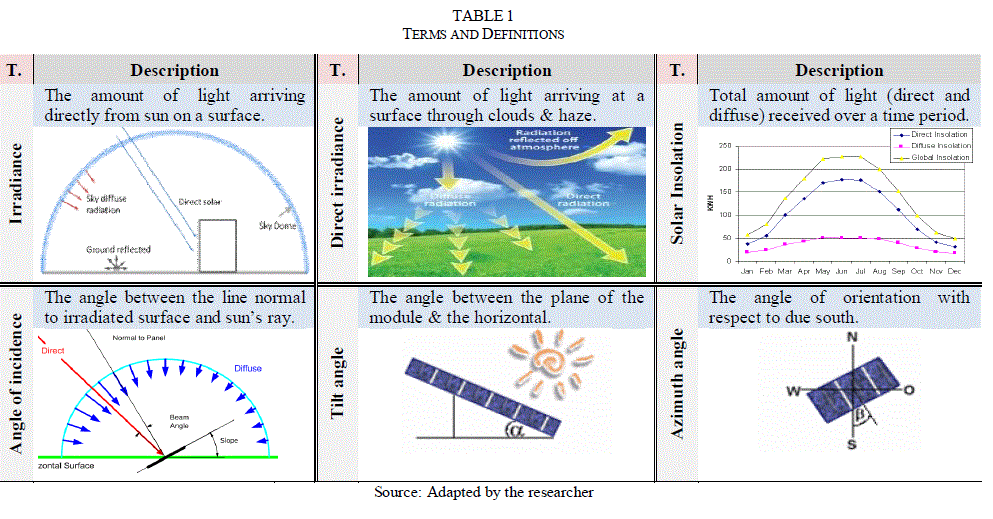 |
| As for tilt angle,it is well-known that the sun’s angle of elevation changes during the year, thus the tilt angle of the array should be chosen so that maximum energy production is guaranteed [9].It is worth mentioning that, in most locations, winter is typically cloudier than summer. Besides, the average morning and afternoon insolation is not symmetric. Consequently, the tilt angle should be selected so as to satisfy the energy demand for the critical design month [10], as shown in Fig. 1.Favoured tilt angle conditions to obtain maximum energy output are shown in Fig. 2. |
 |
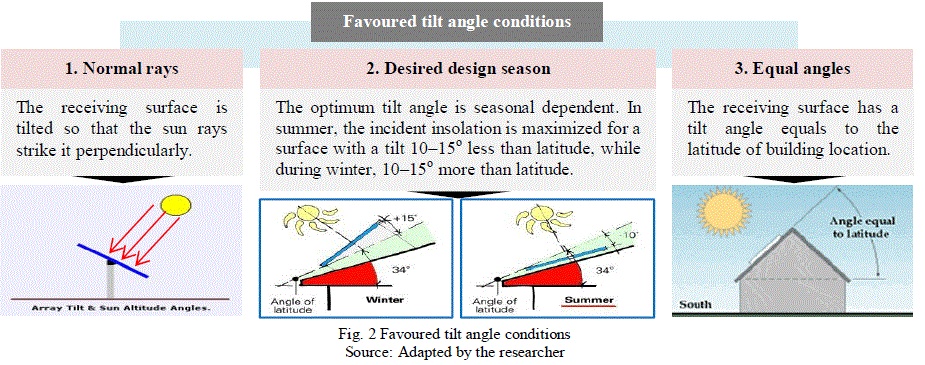 |
| As for orientation, in the Northern Hemisphere, PV arrays should be oriented to face south to receive maximum solar insolation [11].However, exact orientation is not critical; the vertical angle (tilt) has a much important effect on performance. Many studies indicated that surface tilt angles and azimuth angles (orientations) can be varied over a considerable range without significantly reducing the amount of annual incident solar radiation [6],refer to Fig. 3. |
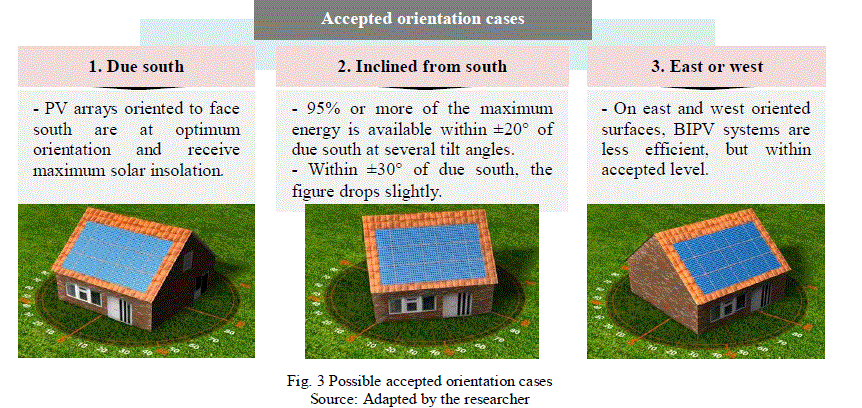 |
| In comparison to a system oriented south at latitude angle, Table 2 shows expected losses due to unfavourable tilts and orientations [12]. |
 |
| It is obvious from the previous table that a good amount of power can be produced in non-optimal tilts and orientation. Moreover, in overcasting conditions, a good power yield can still be achieved, provided that the characteristics of PV modules allow this. Thin-film (TF) modules possess these properties and regularly generate higher yield compared to crystalline (C) ones (see Fig. 4), which prefer directly high solar radiation. Advantages of TF modules are [13]: |
| They perform better in weak light(cloudy and dull weather), even north facing facades can be included. |
| They are recommended in situations where there is a significant proportion of diffuse light due to reflection and light-scattering (by water vapour, dust and soot particles). |
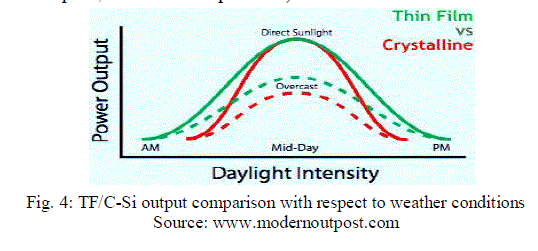 |
BIPV ROOF SYSTEMS |
| In the “BIPV vision”, PVsare not only technical device producing electricity,but it is supposed to be a building component that is able to generate energy when exposed to the sun (a multifunctional product).In principle, BIPV can be appliedon all parts of the building envelope. Consequently, there is a large variety of possible PV integrations in and on buildings [13].A general approach for classification is according to the building part they are integrated into [14]. Accordingly, BIPVs can be classified into four major types (Fig. 5), each type comprises sub-systems beneath. |
 |
| The research will focus on BIPV roof systems,as roofs offer the most attractive opportunity for BIPV installations since roofs usually have the most substantial solar access due to the reason of being free from overshadowing[1]. |
| Table 2 introduces BIPV roof sub-systems. Each sub-system will be described as follows: |
| - System name. - Short description. - An illustrative figure. |
| - Distinguishing features and characteristics. - A project example. |
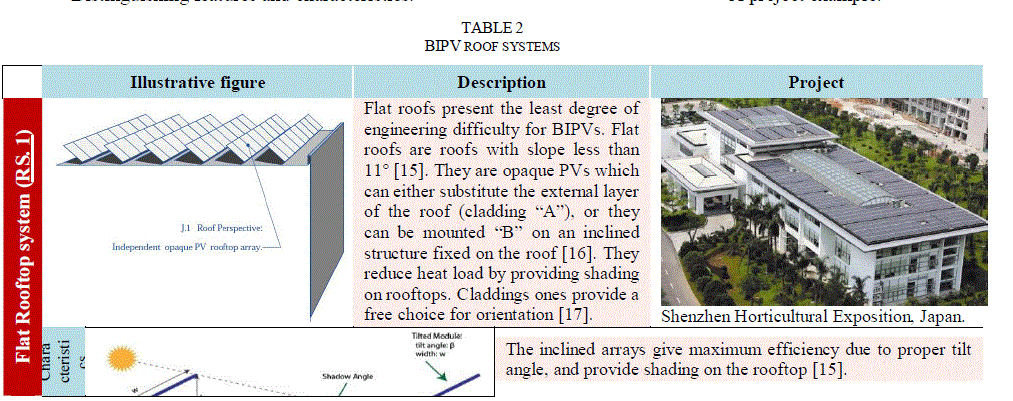 |
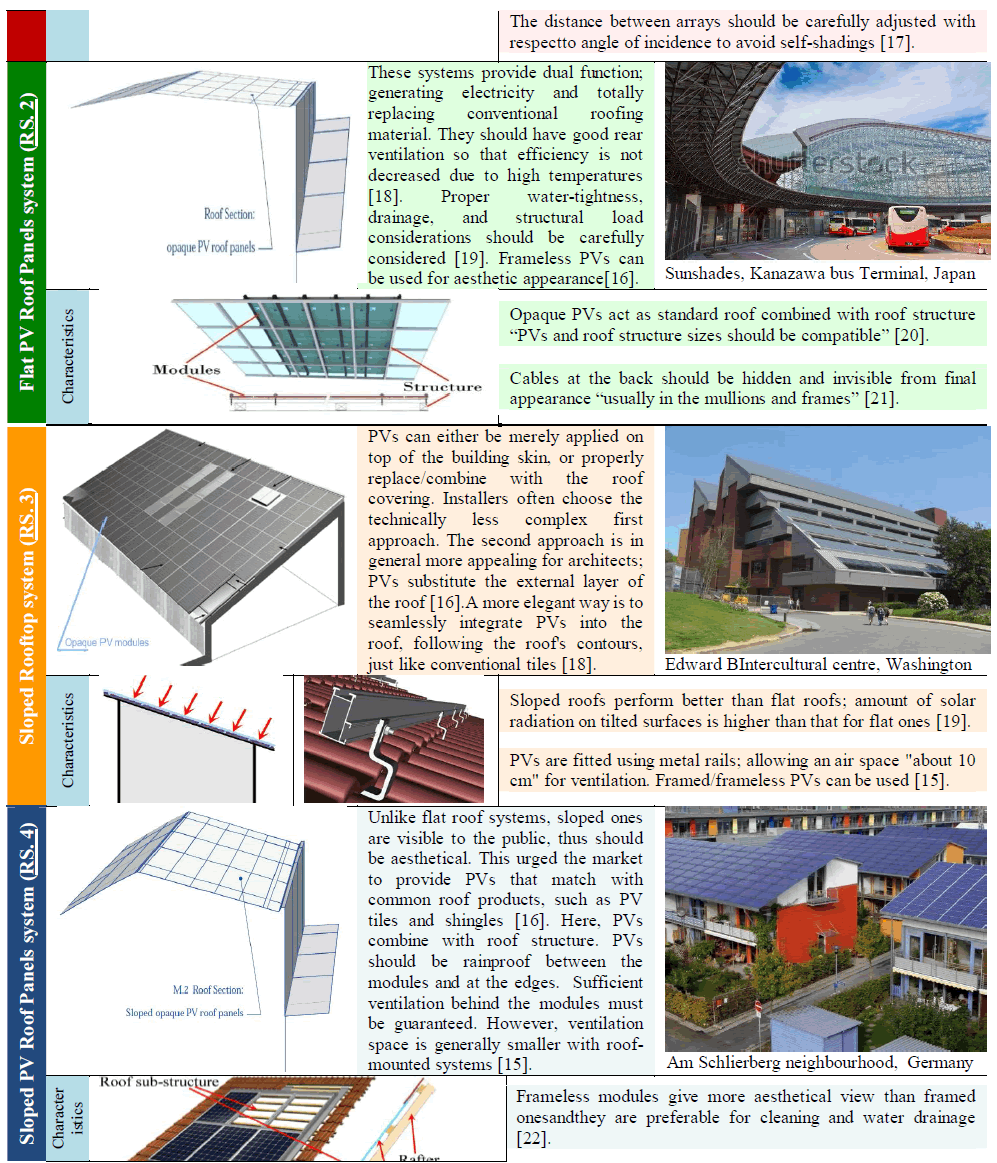 |
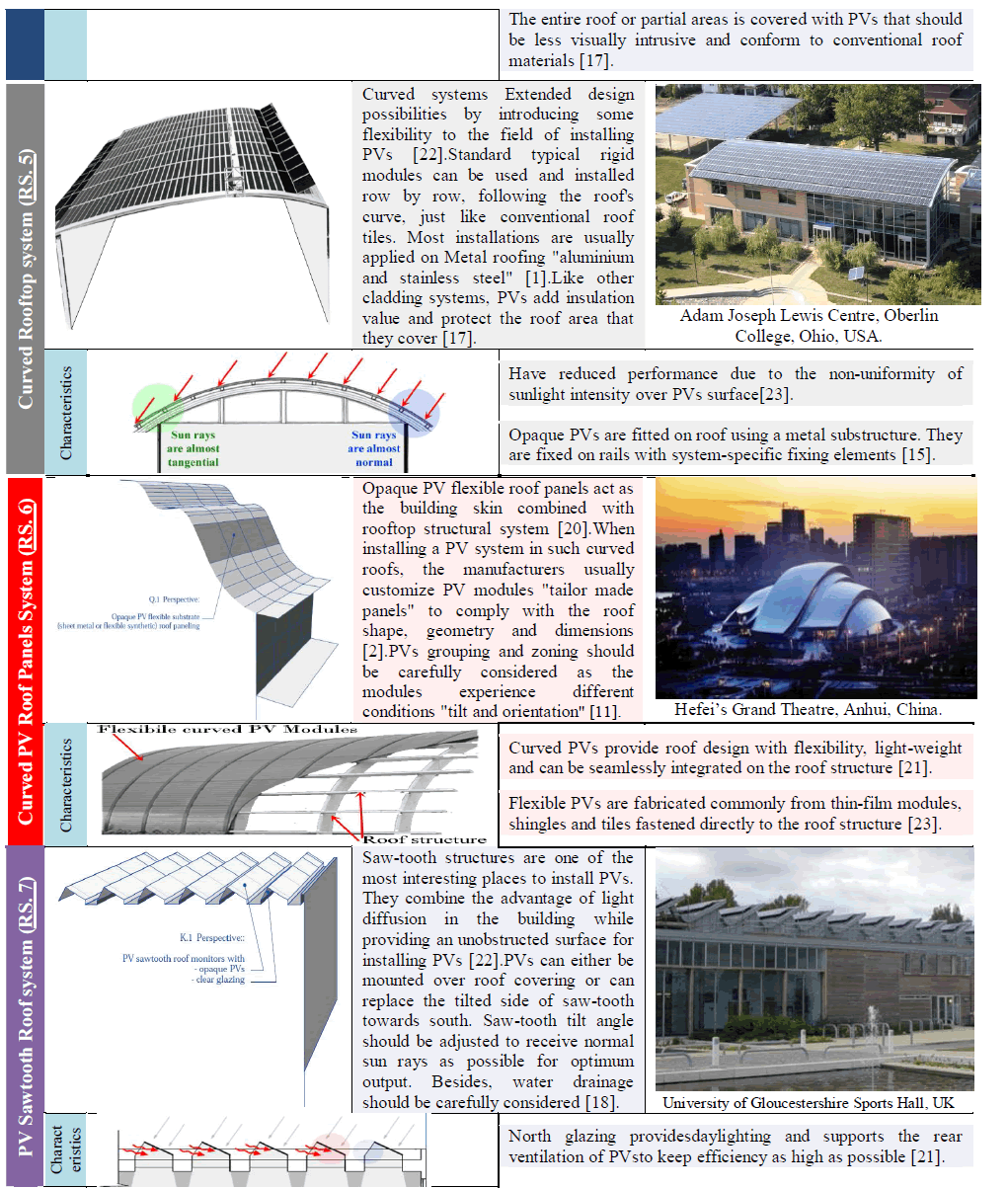 |
 |
THE PREFERENCE MATRIX |
| After what has been discussed above, a preference matrix will be conducted and introduced (see Table 3). This matrix acts as a supporting tool that helps architects and designers choose among various PV roof systems the most convenient one with respect to tilt and orientation factor, taking into account the building and environmental conditions/constraints. |
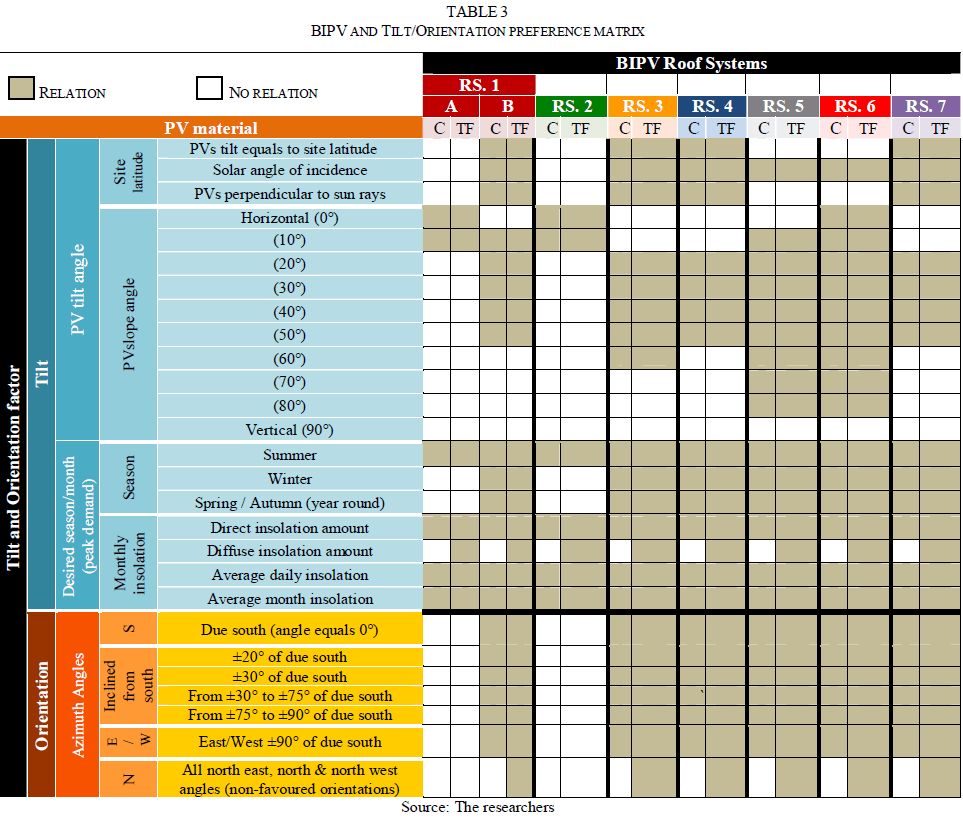 |
| After the systems have been filtered from the above matrix, the appropriate ones should be subjected to software simulation to examine their output power, hence taking the highest available yield output. |
CONCLUSION |
| Based on the research objective, factors analysis, systems description, and conducted preference matrix, the following points have been obtained and concluded: |
| A building orientated to the south for daylighting, passive solar gain and free of overshadowing is eminently suitable for PVs. |
| In non-optimal orientations, specifically in north directions, thin film modules are the preferable. |
| From the matrix, it is obvious that slopped, curved, and saw-tooth systems are moreappropriate with various tilt angles than flat ones. |
| Flat mounted roof systems have more flexibility for tilt angles than flat cladding and flat PV roof panels. |
| Orientation has no effect on flat mounted and flat PV roof panels systems. |
| It is clear from the matrix that tilt is a more critical preference factor than orientation. |
References |
|